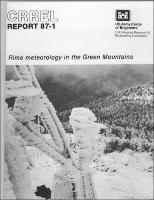Please use this identifier to cite or link to this item:
https://hdl.handle.net/11681/9038Full metadata record
| DC Field | Value | Language |
|---|---|---|
| dc.contributor | University of Vermont. Department of Geography | - |
| dc.contributor.author | Ryerson, Charles C. (Charles Curtis) | - |
| dc.date.accessioned | 2016-06-20T13:39:59Z | - |
| dc.date.available | 2016-06-20T13:39:59Z | - |
| dc.date.issued | 1987-01 | - |
| dc.identifier.uri | http://hdl.handle.net/11681/9038 | - |
| dc.description | CRREL Report | - |
| dc.description | Abstract: Rime icing is a frequent and severe problem in higher elevations of the Green Mountains because it impacts radio and television antennas and ski lifts and could affect high elevation wind machine performance. Rime meteorology, measuring equipment performance, and variation with elevation were analyzed statistically on Mansfield and Madonna Peak, Vermont, during the winters of 1982-83 and 1983-84. Weather conditions were measured from surface weather observations, from rawinsonde 850mb records, and from synoptic weather maps. Rime intensity with time was measured with a Rosemount antenna deicing system on Mt. Mansfield, and rime accretion was measured from collectors installed from 643 to 1227 m on the two peaks. Most rime events in the Green Mountains are of low intensity, with greatest intensities found in warmer, subfreezing air within 5°C of the dew point. Rime was usually most intense within deep low pressure systems, and was associated with 9- to 10-tenths cloud cover and light precipitation. Rime was rarely associated with high pressure. Most rime events occurred within cold and occluded fronts in southerly to westerly winds. Rime was most intense on the trailing side of cyclones as they moved eastward and poleward of northern Vermont. Nearly all rime deposits during the study period were from the west and northwest. Rosemount ice detector performance on Mt. Mansfield compared favorably to performance of an identical detector on Mt. Washington under similar icing intensities. Feather growth rates were not measured accurately by the Rosemount detector, however. Feathers on equipment exposed similarly to the Rosemount grew at nearly twice the rate indicated by the Rosemount detector. Rime accretion increases at an increasing rate with elevation in the Green Mountains. Rime events are infrequent and have low intensities below 800 m. Rime accretion near the ground surface also correlated with relief exposure, with promontories accumulating more rime than hollows. | - |
| dc.publisher | Cold Regions Research and Engineering Laboratory (U.S.) | - |
| dc.publisher | Engineer Research and Development Center (U.S.) | - |
| dc.relation | http://acwc.sdp.sirsi.net/client/en_US/search/asset/1001162 | - |
| dc.relation.ispartofseries | CRREL report ; 87-1. | - |
| dc.rights | Approved for public release; distribution is unlimited. | - |
| dc.source | This Digital Resource was created from scans of the Print Resource | - |
| dc.subject | Green Mountains | - |
| dc.subject | Mountain weather | - |
| dc.subject | Synoptic meteorology | - |
| dc.subject | Ice detectors | - |
| dc.subject | Rime ice | - |
| dc.subject | Vermont | - |
| dc.subject | Mt. Mansfield | - |
| dc.subject | Rime meteorology | - |
| dc.subject | Vertical variation | - |
| dc.title | Rime meteorology in the Green Mountains | - |
| dc.type | Report | en_US |
| Appears in Collections: | CRREL Report | |
Files in This Item:
| File | Description | Size | Format | |
|---|---|---|---|---|
| CRREL-87-1.pdf | 1.48 MB | Adobe PDF |  View/Open |